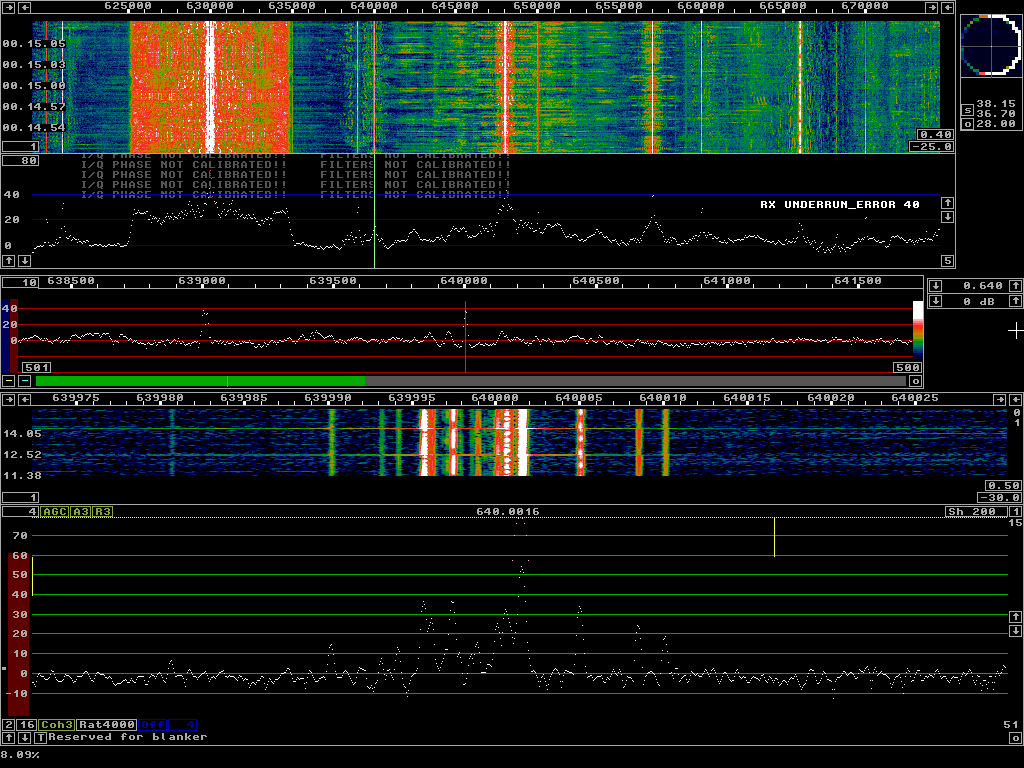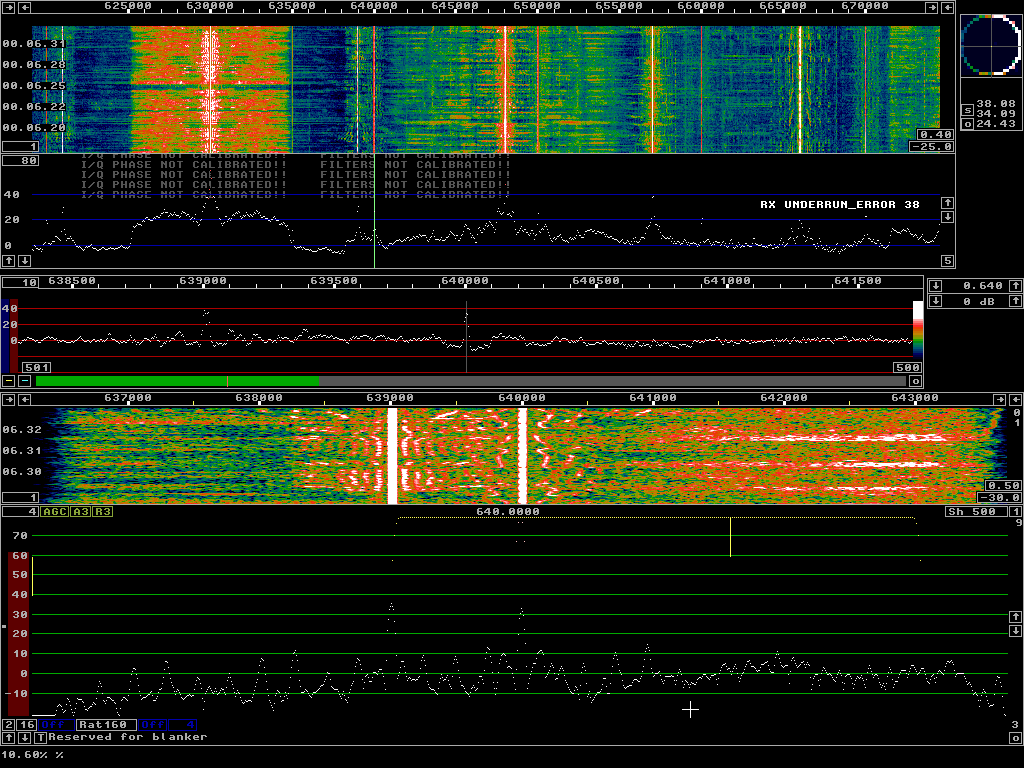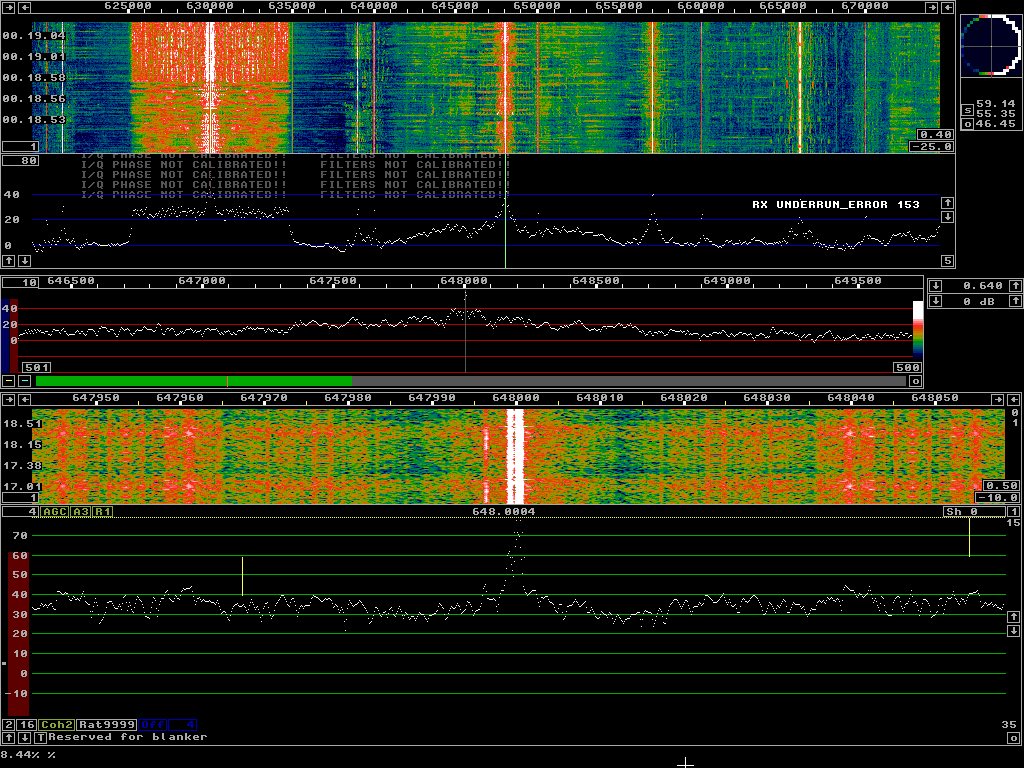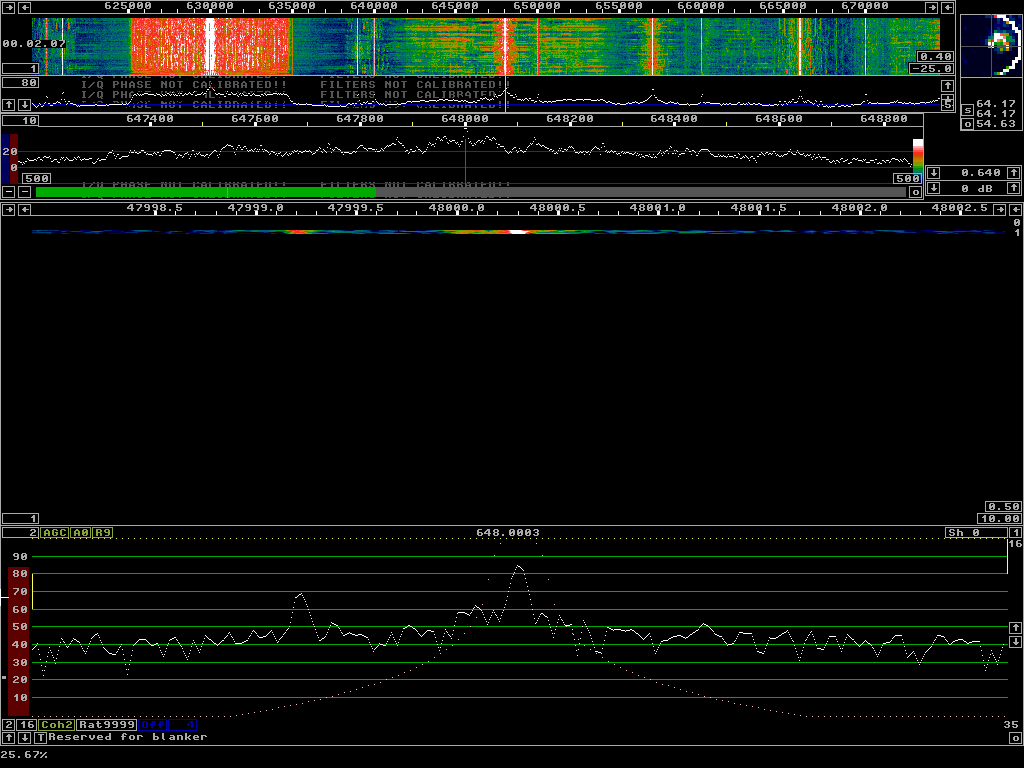
|
On MW the AM broadcast stations are channelized differently
on different continents.
In Europe the channel spacing is 9 kHz while it is 10 kHz in the USA.
The recording presented on this page
640-test_000.wav (69488726 bytes)
was recorded by
Jurgen Bartels
on February 2 2009.
The zipped file can be downloaded here
640-test_000.zip (56930775 bytes)
In this file the center frequency is 640 kHz.
Figure 1 shows Linrad running with the simple AM detector
with a filter that selects the frequency range 639.07 to 641.33 kHz.
The loudspeaker signal, am-1330.mp3 (111700 bytes)
has a limited bandwidth,
the highest audio frequency is 1.33 kHz and the frequency range
930 Hz to 1.33 kHz is attenuated by 6 dB since the lower sideband
is missing in that range.
The dominating station on 640 kHz is CBN St. Johns, New Foundland,
with CBC Radio-1 programming.
The lower frequency is set just above 639 kHz, the carrier frequency of RNE, Radio Nacional, Spain. The upper sideband of RNE is similar in amplitude to the lower sideband of the desired signal, CBN, so it generates interference by its legitimate emission. The upper frequency is set to avoid most of the splatter from BBC World Service with carrier frequency 648 kHz. BBC generates sidebands all the way down to 641 kHz for a total bandwidth of about 14 kHz. The excess bandwidth, signals emitted outside the range 643 to 653 kHz is what I prefer to call splatter. BBC seems to be slightly overmodulated and produces a lot of splatter. In contrast, the Norwegian station on 630 kHz has much less splatter with 30 dB or more suppression of unintended sidebands. |

|
|
Fig 1. Conventional AM.
The station at 640 kHz is received with a filter that
selects the frequency range 639.07 to 641.33 kHz.
Figure 2 shows the Linrad screen when Linrad is set to use coherent processing. Here the upper and lower frequency limits are the same as in figure 1, but the baseband FFT size is 65536 rather than 512 so the frequency scale is expanded by 128 as compared to figure 1. |

|
|
Fig 2. Coherent processing.
The station at 640 kHz is received with a filter that
selects the frequency range 639.07 to 641.33 kHz.
It is obvious from figure 2 that there are many different stations on 640 kHz. The strongest one, at 640001.6 Hz is about 15 dB stronger than the four stations on 639995.7, 639997.4, 640000.6 and 640005.0 Hz. These four stations produce uncorrelated signals so they should add to produce four times more interference than a single station. That means that co-channel interference is expected at about -9 dB. The remaining about 10 signals are weak and do not affect detection of the desired signal. As can be seen in figure 2, the narrow filter which is 4000 times narrower than the main filter is centered at 640001.6 Hz. The only signal that can pass through this filter is the carrier of CBN, the desired station. The pure carrier obtained this way is used to shift the phase of the signal that has passed the wide filter so its phase becomes the same as the carrier phase. That is an I/Q demodulator. I contains amplitude modulation and Q contains frequency/phase modulation. In this case we expecet I to contain the AM modulation of CBN St. Johns, New Foundland plus 50% of the interference while Q should contain interference only. This file coh3-1330.mp3 (111700 bytes) is the I signal which is obtained as the loudspeaker output of Linrad in mode Coh3. The improvement should be 3 dB since 50% of the signal energy from interference sources appear in the Q channel which is discarded. The detection procedure was developed for Morse telegraphy where the coherence between dots and dashes can be utilized this way. When the method is used for AM detection the conventional name is synchronous AM detection SAM. This file coh2-1330.mp3 (371356 bytes) is a stereo recording with the I signal in channel 1 and the Q signal in channel 2. This is the loudspeaker output of Linrad in mode Coh2. Had there been a second station at 640 kHz that were 6 to 10 dB below the dominating signal with all other stations much weaker it should have been possible to copy fragments of the second station in the Q channel. The coherent detect algorithm would not work as well if the carrier were extracted by the filter shown in figure 1. The presence of all the other carriers would make the phase incorrect so the signal of CBN would not become near zero in the Q channel where it would have made a weaker signal more difficult to hear in case one had been present. Figure 3 shows conventional AM detection in a somewhat larger bandwidth. The upper sideband is used up to 3 kHz from the carrier so the audio bandwidth is larger - but there is also more splatter from the station at 648 kHz. Here is the loudspeaker output: am-3000.mp3 (111700 bytes) |

|
|
Fig 3. A filter that uses 1 kHz from the lower sideband and
3 kHz from the upper sideband is shown here.
When the filter in figure 3 is used for coherent detection, Coh3, the loudspeaker output sounds like this: coh3-3000.mp3 (111700 bytes) The coherent processing in Linrad is just a very small improvement when it comes to suppress overlapping sidebands and splatter from close spaced stations. It is obvious from the waterfall graph that one can identify a large fraction of the signals in the overlapping region 639 to 640 kHz and attribute them to one or the other carrier just by an inspection by eye on the power spectra (waterfall.) Surely it must be possible to do even better with some kind of algorithm that also takes the phase into account. It is clear however that the interferer at 639 kHz has two equally strong carriers so one would have to attribute the sidebands to one or the other of them and therefore the problem is not easy. BBC on 648 kHz is also not alone on its frequency as can be seen in figure 4. |

|
|
Fig 4. BBC at 648 kHz is accompanied by another
station about 1 Hz lower in frequency and with a signal
amplitude that is 10 to 15 dB below BBC.
This file: sig648.mp3 (371357 bytes) is the output from coherent processing (Coh2.) It is a stereo recording with the dominant signal in channel 1. In channel 2 one can hear the weaker station better than with the conventional AM detector, but the improvement is small. BBC is distorted by some selective fading or other phenomenon that degrades the symmetry of its sidebands and therefore it is contributing significantly in channel 2, the Q channel. Also for BBC it would be difficult to try to cancel the interference on CBN by use of the symmetry of AM sidebands. The second station on 648 kHz is 1.09 Hz below BBC and its identity is unknown (to me.) It is clear that it is modulated by the signal that appears in the Q channel of BBC in Coh2 mode because it moves to the I channel when its carrier is selected in Coh2 mode. Figure 5 shows the Linrad screen at higher resolution. The file is not long enough to allow better resolution than that. |

|
|
Fig 5. BBC and its companion on 648 kHz at high
resolution. The bin separation is 0.03 Hz.
As a general conclusion, separating AM stations by use of the symmetry of AM sidebands is a difficult task. A far better solution to the serious DX-er would be to use a receiver with more channels. Orthogonalizing signals that arrive from different antennas is a standard procedure, adaptive lobe formation, and the hardware required to do it at an affordable cost should become available within a couple of years. For the amateur radio bands such hardware has been available several years in the WSE converters. Linrad has software to use two channels for S/N optimization of weak signals in a background of white noise. It should however be reasonably easy to add routines to eliminate interference between AM stations relatively easily provided that the phase and or amplitude relation differs between the RF channels. The optimum settings for reception of CBN at 640 kHz with Perseus.exe according to Jurgen Bartels are shown in figure 6. The linrad files above do not use the lower modulation sideband of CBN below 639 kHz. Perseus.exe allows only the carrier at 639 and its nearest sidebands to be removed with a notch. It is clear from figure 6 that Jurgen found it best to include the lower sideband all the way down to 636 kHz while not using the upper sideband above 641 kHz where the splatter from BBC dominates. The loudspeaker output from Perseus.exe sounds like this: 640-test.mp3 (137216 bytes) |

|
|
Fig 6. Receiving at 640 kHz with Perseus.exe.
With Linrad-03.03 and later there is an option to insert notch filters in the passband. (Actually up to 9 notches cab be inserted.) Figure 7 shows Linrad processing CBN at 640 kHz with filter settings similar to those used with Perseus in figure 6. With increased fft3 size and coh3 mode the loudspeaker output of the filter shown in figure 7 is like this: coh3-notch.mp3 (222877 bytes) The entire file is 92 seconds. Those 33 seconds that correspond to the output from Perseus.exe are contained in this file: part-coh3-notch.mp3 (229669 bytes) The difference between Perseus.exe and Linrad should be very small, but I have no means to compare them accurately. The only difference should be that SAM in Perseus.exe uses the instantaneous sum of all the carriers at 640 kHz while Linrad uses the carrier actually belonging to CBN. |

|
|
Fig 7. Receiving CBN at 640 kHz with Linrad with a notch
in the passband to attenuate RNE at 639 kHz.
To SM 5 BSZ Main Page |